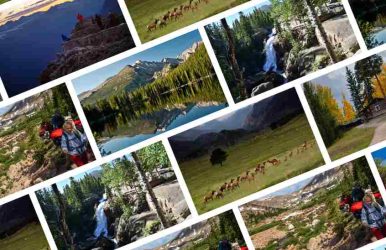Exploring The World While Investing In It: The Vacation Property Guide
BY Shahnawaz Mar 1, 2024
In today's world, where wanderlust meets savvy investment strategies, there's a growing trend among travelers and investors alike: vacation properties. This unique approach not only satisfies the urge to explore new destinations but also presents a prudent financial investment through the acquisition of real estate. Here's how blending the love for travel with the intricacies of mortgages can create a rewarding venture. Why Consider Vacation Properties? Vacation properties serve dual purposes; they are a getaway retreat for you and your family and a potential source of income through rental. In picturesque locales, from the sandy beaches of Bali to the quaint villages of Tuscany, these properties beckon with the promise of adventure and the allure of financial returns. Investing in a vacation property has a lot of benefits. The first thing is, as mentioned above, it is an amazing source of passive income. When you rent out the property, you get back substantial returns, especially during the peak seasons. Moreover, vacation rentals have higher rental rates as compared to long-term rentals, which gives you more revenue. Along with the financial benefits, when you own a vacation rental property, you get to spend a lot of time enjoying your personal vacations as well. You can spend a lot of time on your own property when the place is vacant. You get to enjoy all the amenities you have set for others.it is a perfect relationship between investment and vacation home. Understanding the Mortgage Process for Vacation Homes Investing in a vacation property often involves navigating the mortgage landscape, which can be daunting for both seasoned investors and first-time buyers. The process entails several unique considerations: Interest Rates and Terms: Mortgage loans for vacation homes may come with different interest rates and terms compared to primary residences. Lenders often view these properties as higher risk, which can influence the loan conditions. Down Payment Requirements: Typically, vacation homes require a larger down payment, sometimes as much as 20-30% of the purchase price, reflecting their status as luxury or non-essential purchases. Rental Income Consideration: If you plan to rent out your vacation home, lenders might take potential rental income into account, which can aid in qualifying for a mortgage. However, this requires thorough documentation and, sometimes, previous landlord experience. The Joy of Travel and the Wisdom of Investment Owning a vacation property allows you to immerse yourself in your favorite destinations. Whether it's a ski lodge in the Rockies or a beachfront villa in the Caribbean, these homes offer a personal escape with the warmth and comfort of your own space. Beyond personal enjoyment, these properties can be rented out to vacationers, providing a steady income stream that can offset mortgage payments and maintenance costs. Navigating Challenges and Rewards The journey of buying and owning a vacation property is not without its challenges. From managing the property remotely to understanding local real estate laws, it requires diligence and research. Yet, the rewards can be substantial. Not only do you enjoy personal retreats in beloved locales, but you also stand to gain from property appreciation and rental income. A Call to Adventure and Investment As we navigate our world, the concept of investing in vacation properties presents a compelling blend of adventure and financial prudence. It embodies a spirit of exploration, not just in the sense of travel but in the realm of financial growth and stability. For those bitten by the travel bug and those seeking to expand their investment portfolio, vacation homes offer a horizon worth exploring. Factors you should consider while choosing the location of the property Picking the correct location for your vacation rental property is essential. Here are some of the crucial factors that you should consider: Factors you should consider while choosing the location of the property Picking the correct location for your vacation rental property is important. Here are some of the important factors that you should consider: Local attractions and tourism demand How successful your vacation rental property is going to be depends on the demand of the place. Before you invest, check for the popularity of the place among travelers. Identify the local attractions that are drawing the visitors to itself. Consider the things that are making the place popular. Whether it is their cultural heritage, its natural beauty, or how close the place is to the popular destinations. Properties that are close to tourist spots or close to vacation destinations have a tendency to attract more renters. You can choose coastal destinations, urban hotspots, ski resorts, historical and cultural sites, and some emerging destinations. Along with the well-established vacation sports, the emerging destinations are a good investment. Look for places that are rapidly developing; they have high potential for getting you a high rental return. Rental and seasonality demand Having a good understanding of the tourist season in the place is important. Research about the holidays, special events, and the peak tourist seasons that will take the rental demand to the next level. If the location is such, which has a year-round demand, it is going to get you a consistent source of income. But if the property is in a seasonal location, then you might get fluctuations in the rental bookings. Regulatory environment Before you get a vacation rental property, it is important to know the regulatory environment of the location. Some countries and cities have specific rules and regulations regarding short-term rentals. Get yourself familiar with the restrictions and local laws to make sure you abide by all the regulations. Try not to ignore the legal aspects, as that could land you with a penalty or even cause your rental business to close. Amenities and infrastructure Think about the accessibility and proximity of the essential infrastructure as well as the amenities. Choose an area that has good transportation links, restaurants, shopping centers, and entertainment options. Guests always prefer properties that are convenient and have easy access to the services and local attractions. Final Thoughts Before embarking on this journey, it's crucial to conduct thorough research, consult with real estate and financial professionals, and consider all aspects of the investment, including the potential need for a mortgage. With the right preparation and mindset, owning a vacation property can be an enriching experience that combines the joys of travel with the benefits of real estate investment. ADDITIONAL READING: A Guide To Planning Your First Family Ski Trip The Ultimate Business Traveler’s Guide To Bangkok From Britain To Australia: A Guide For Brits Making The Move Down Under






















Very descriptive article, I liked that a lot.
Will there be a part 2?
Thanks for your valuable comment. And yes till then stay tuned for upcoming posts…
My spouse and i ended up being absolutely joyous when Jordan could finish up his research from your precious recommendations he obtained through the web site. It is now and again perplexing just to continually be offering guidelines which the rest have been making money from. We really take into account we have got the blog owner to give thanks to for that. These explanations you have made, the simple site navigation, the friendships you make it possible to promote – it’s many great, and it’s leading our son in addition to the family feel that this theme is cool, which is unbelievably mandatory. Many thanks for all the pieces!
Thank you so much. Means a lot when I come across comments like this.
Terrific post but I was wondering if you could write a litte more on this subject? I’d be very thankful if you could elaborate a little bit further. Appreciate it!
Thanks for your valuable comment. Sure, we are trying to cover more information on each of these sites with reviews. You may already get some of these here. Till then, stay tuned for upcoming posts…
I blog frequently and I genuinely appreciate your
information. This great article has really peaked my interest.
I am going to take a note of your website and keep checking for new details about once
per week. I opted in for your Feed as well.